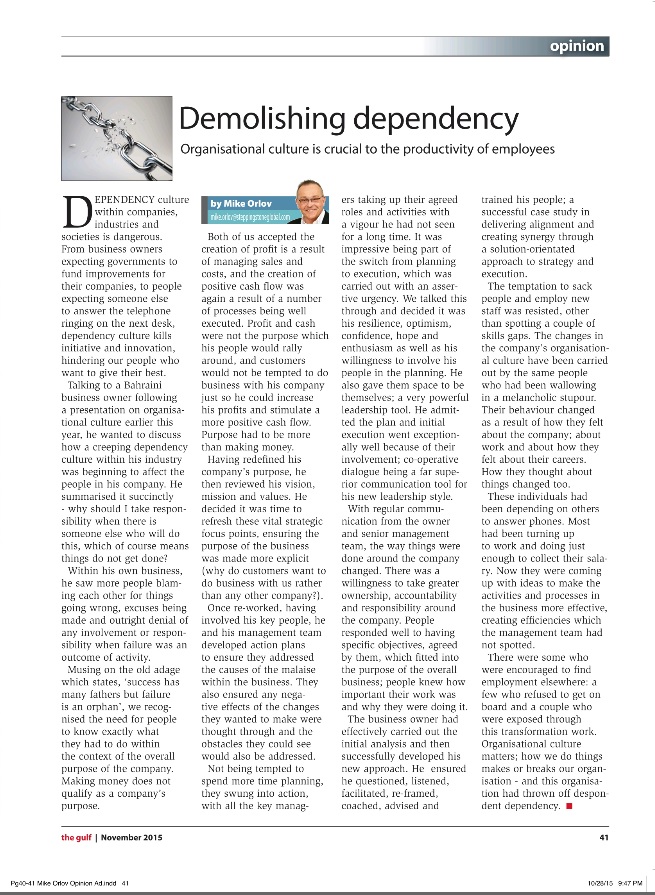Demolishing Dependency
Dependency culture within companies, industries and societies is dangerous. From business owners expecting governments to fund improvements for their companies, to people expecting someone else to answer the telephone ringing on the next desk, dependency culture kills initiative and innovation, hindering our people who want to give of their best.
Talking to a Bahraini business-owner following a presentation on Organizational Culture earlier this year, he wanted to discuss how a creeping dependency culture within his industry was beginning to affect the people in his company. He summarized it succinctly; why should I take responsibility when there is someone else who will do this, which of course means things do not get done.
Within his own business, he saw more people blaming each other for things going wrong, excuses being made and outright denial of any involvement or responsibility when failure was an outcome of activity.
Musing on the old adage which states, ‘success has many fathers but failure is an orphan’, we recognized the need for people to know exactly what they had to do within the context of the overall purpose of the company. Making money does not qualify as a company’s purpose.
Both of us accepted the creation of profit is a result of managing sales and costs, and the creation of positive cash-flow was again a result of a number of processes being well executed. Profit and cash were not the purpose which his people would rally around, and customers would not be tempted to do business with his company just so he could increase his profits and stimulate a more positive cash-flow. Purpose had to be more than making money.
Having re-defined his company’s purpose, he then reviewed his vision, mission and values. He decided it was time to refresh these vital strategic focus-points, ensuring the purpose of the business was made more explicit (why do customers want to do business with us rather than any other company?).
Once re-worked, having involved his key people, he and his management team developed action plans to ensure they addressed the causes of the malaise within the business. They also ensured any negative effects of the changes they wanted to make were thought-through and the obstacles they could see would also be addressed.
Not being tempted to spend more time planning, they swung into action, with all the key managers taking up their agreed roles and activities with a vigor he had not seen for a long time. It was impressive being part of the switch from planning to execution, which was carried out with an assertive-urgency. We talked this through and decided it was his resilience, optimism, confidence, hope and enthusiasm as well as his willingness to involve his people in the planning. He also gave them space to be themselves; a very powerful leadership tool. He admitted the plan and initial execution went exceptionally well because of their involvement; cooperative dialogue being a far superior communication tool for his new leadership style.
With regular communication from the owner and senior management team, the way things were done around the company changed. There was a willingness to take greater ownership, accountability and responsibility around the company. People responded well to having specific objectives, agreed by them, which fitted into the purpose of the overall business; people knew how important their work was and why they were doing it.
The business-owner had effectively carried out the initial analysis and then successfully developed his new approach. He ensured he questioned, listened, facilitated, re-framed, coached, advised and trained his people; a successful case-study in delivering alignment and creating synergy through a solution-orientated approach to strategy and execution.
The temptation to sack people and employ new staff was resisted, other than spotting a couple of skills gaps. The changes in the company’s organizational culture have been carried out by the same people who had been wallowing in a melancholic stupor. Their behavior changed as result of how they felt about the company; about work and about how they felt about their careers. How they thought about things changed too.
These individuals had been depending on others to answer phones. Most had been turning up to work and doing just enough to collect their salary. Now they were coming up with ideas to make the activities and processes in the business more effective, creating efficiencies which the management team had not spotted.
There were some who were encouraged to find employment elsewhere: a few who refused to get on board and a couple who were exposed through this transformation work. But it was the available human resources who made it all happen. Continuous maintenance of the current position is now vital, as well as being ever-alert to new threats and opportunities.
Organizational culture matters; how we do things makes or breaks our organization – and this organization had thrown-off despondent dependency.

